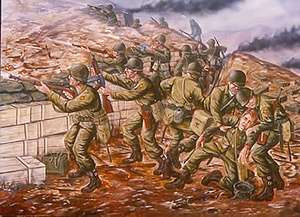
Back Batalla de Pork Chop Hill Spanish ポークチョップヒルの戦い Japanese 폭찹힐 전투 Korean Bitwa o Pork Chop Hill Polish ยุทธการที่เนินพอร์กช็อป Thai 石峴洞北山戰鬥 Chinese
| Battle of Pork Chop Hill | |||||||
|---|---|---|---|---|---|---|---|
| Part of the Korean War | |||||||
 Painting of the 45th Infantry Division at Pork Chop Hill in 1953 | |||||||
| |||||||
| Belligerents | |||||||
|
| |||||||
| Commanders and leaders | |||||||
|
|
| ||||||
| Units involved | |||||||
|
|
| ||||||
| Strength | |||||||
| 19,000 men |
20,000 men (UN estimate) 6,800 (in July battle) | ||||||
| Casualties and losses | |||||||
|
US: 3,500 killed or wounded |
UN estimate 1,500 killed 4,000 wounded Chinese source: 533 killed 1,242 wounded (in July battle) | ||||||
Location within North Korea | |||||||
The Battle of Pork Chop Hill, known as Battle of Seokhyeon-dong Northern Hill (Chinese: 石峴洞北山戰鬥) in China, is a pair of related Korean War infantry battles that took place on April 16 and July 11, 1953 while the United Nations Command (UN) and the Chinese and North Koreans were negotiating the Korean Armistice Agreement.
In the United States, the battles were controversial because of the large number of soldiers killed for terrain with no strategic or tactical value, but according to US sources, which are disputed by Chinese sources, the Chinese lost many times the number of US number killed and wounded. The first battle was described in the eponymous history Pork Chop Hill: The American Fighting Man in Action, Korea, Spring 1953, by S.L.A. Marshall, from which the film Pork Chop Hill was drawn. The UN won the first battle, but the Chinese won the second battle.
The UN forces, supported primarily by the United States, won the first battle when the Chinese broke contact and withdrew after two days of fighting. The second battle involved many more troops on both sides and was bitterly contested for five days, when the UN conceded the hill to the Chinese by withdrawing behind the main battle line.
